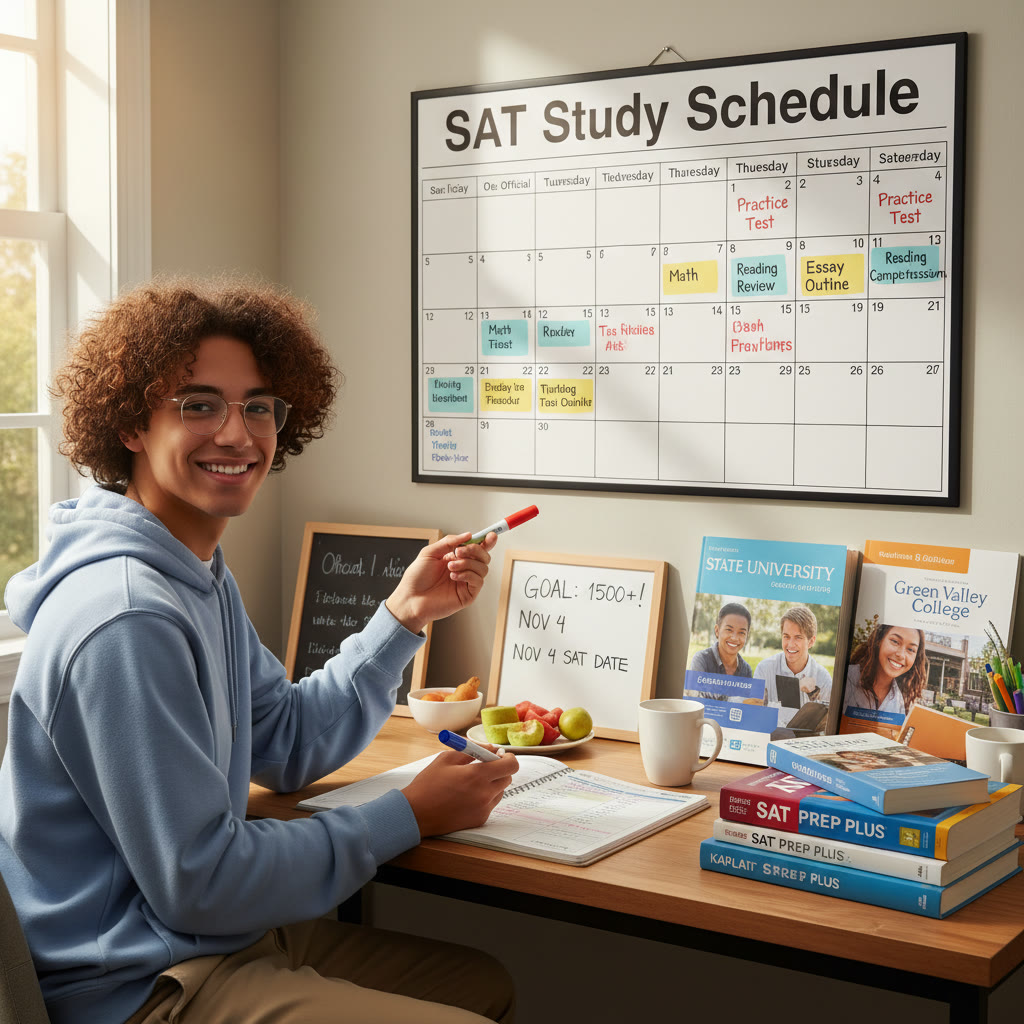Balancing SAT Prep and College Applications: A Calm, Practical Roadmap
There’s a special kind of pressure that hits in junior and senior year: college essays, recommendation letters, extracurricular lists—and somewhere in the mix, the SAT. It can feel like spinning plates. But with a clear plan, realistic time blocks, and a few smart shortcuts, you can keep your sanity and get great results on both fronts.
This guide is written for students who want a friendly, human approach: the kind of advice a good mentor would give you over coffee. It’s practical, flexible, and meant to be adjusted to your life—sports, jobs, family obligations included. I’ll walk through timelines, weekly schedules, priority decisions, and—where it fits naturally—how Sparkl’s personalized tutoring can support a tailored plan so you don’t have to do this alone.
Why it feels impossible (and why it isn’t)
When you’re juggling SAT prep and college applications, two things make it look overwhelming: both are high-stakes, and both require concentrated effort. The good news is they don’t require the same type of mental energy at the same time. SAT prep rewards focused, practiced effort—short, repeated cycles. Applications reward reflection, editing, and external feedback—slower, iterative work.
Think of them as two different muscles. With a little scheduling finesse, you can train both without overworking either.
Big-picture timeline: start with the end in mind
Before any schedule, map deadlines. Create a simple timeline with test dates and application milestones. Below is a sample timeline you can adapt. If your deadlines are different—early decision, rolling admissions, or gap years—shift the months accordingly.
| Month | Primary Focus | Major Tasks | Recommended Weekly Hours |
|---|---|---|---|
| Junior Year Spring | Baseline & Planning | Take practice SAT, evaluate strengths, begin list of colleges, draft timeline | 3–6 hrs |
| Summer (before Senior Year) | Intensive Prep & Brainstorming | Targeted SAT study, draft essays, collect activities, request teacher recs | 8–15 hrs |
| Senior Year Early Fall | Finalize Materials | Finish essays, finalize college list, take SAT/subject tests if needed | 6–10 hrs |
| Senior Year Fall/Winter | Applications & Final Testing | Submit early apps, retake SAT if needed, polish supplements | 6–12 hrs |
| Senior Year Spring | Decisions & Wrap-up | Finalize FAFSA/CSS, respond to acceptances, focus on final grades | 3–6 hrs |
This table helps you see that the heaviest overlap—intensive SAT study and application writing—usually happens in the summer and early fall. That’s where intentional planning matters most.
Make a weekly routine that actually fits your life
A common mistake is trying to study for a fixed number of hours every day, rain or shine. Flexibility wins. Instead, build a weekly routine that considers your hardest days and reserves quality time for both SAT study and application tasks.
- Identify two high-focus windows each week (90–120 minutes) for SAT practice: full sections, timed essays, or targeted weak-skill drills.
- Schedule one longer block (2–4 hours) on a low-commitment day (weekend or study hall) for application work: brainstorming, drafting, or editing essays.
- Use short daily habits: 20–30 minutes of vocabulary, math drills, or reading passages. These are low-friction and maintain momentum.
- Reserve one weekly review session (30–60 minutes) to track progress and adjust the plan.
Example weekly split for a busy senior (sports, part-time job):
- Monday: 20 min vocab + 30 min essay brainstorming
- Wednesday: 90 min SAT practice (timed section)
- Friday: 20 min math drill + 30 min application edits
- Saturday: 3-hour block—full practice test OR essay writing/editing
- Sunday: 30 min review + set goals for next week
Prioritize: what to do first when time is tight
Sometimes life is unpredictable: an injury, a sudden family commitment, or exam week. Here’s how to triage:
- If an application deadline is within two weeks: prioritize application materials. Missing a deadline is final; you can retake the SAT later.
- If you have a test within two weeks and no tight application deadlines: focus on SAT prep. Short-term score improvements are doable with focused practice.
- In normal months, alternate weekly focus: one week heavier on SAT practice, the next heavier on essays and supplements. This keeps both moving forward.
Quality beats quantity: how to study smarter, not longer
Long hours aren’t always effective. Here are practices that give strong returns on your time.
- Active practice: do full, timed sections and then analyze every mistake. Don’t just mark answers—understand why you missed them.
- Target weaknesses: cycle math problem types (algebra, geometry, data analysis) instead of randomly doing mixed sets.
- Simulate test conditions once every 2–3 weeks with a full-length test. The rest of the time, focus on targeted drills.
- Use the application work as a low-intensity cognitive break from test prep—brainstorming or freewriting is creative, not draining.
Sample 8-week plan before a big SAT test
This plan balances steady practice with light application progress. Adjust hours to fit your schedule.
| Weeks | SAT Focus | Application Focus |
|---|---|---|
| Weeks 1–2 | Diagnostic test, set target score, review major error types | Outline essays, collect activity descriptions |
| Weeks 3–4 | 2 timed sections/week, targeted math drills, vocabulary routines | Write first drafts for 1–2 essays, request teacher recs |
| Weeks 5–6 | Full practice test every 2 weeks, refine timing strategies | Revise essays with feedback, finalize college list |
| Weeks 7–8 | Peak week: one full practice test, light drills, rest before test | Polish supplements, prepare application materials for submission |
Real-world examples: how students make it work
Case 1: Maya, varsity swimmer and AP student
Maya had early morning practices and two AP classes. She scheduled SAT work in small chunks—20–30 minute math drills after breakfast and a 90-minute practice section once a week. Her longer college-essay blocks happened Sunday afternoons when practice was light. She used one tutor session every two weeks to keep accountability and get feedback on essays and weak math areas. The tutor worked with her schedule and helped her target high-yield math habits.
Case 2: Jamal, part-time worker aiming for early decision
Jamal needed a high score by October and an early application submitted in November. He front-loaded SAT prep over the summer with 10–12 hours/week and wrote application drafts during weekdays in 45–60 minute blocks. He booked a few sessions with Sparkl’s personalized tutoring to create a tailored study plan and to refine his essays; the 1-on-1 guidance reduced wasted time and helped him improve in both areas simultaneously.
How tutoring and tools can accelerate both tracks
You don’t have to go it alone. Tutors and structured programs are not just about teaching content—they provide accountability, custom pacing, and efficient practice. Sparkl’s personalized tutoring, for instance, blends expert tutors with AI-driven insights to create a study plan that fits your college application timeline. That means fewer hours spent on low-impact activities and more time on what raises your score and strengthens your applications.
Good tutors can also act as editors and brainstorming partners for essays, making the dual workload lighter because two different experts (test coach and essay mentor) are synchronized instead of disconnected.
Essay writing and SAT prep: complementary, not competing
Essay writing and SAT study use overlapping skills: clarity of thought, structured arguments, and precise language. Here’s how to use one to benefit the other.
- Reading comprehension practice for the SAT improves your ability to craft tight, evidence-based paragraphs in essays.
- Timed essay practice sharpens your ability to write under pressure—handy for certain college supplements.
- Vocabulary study can elevate essay tone, but remember—use words naturally.
Don’t try to force SAT-style language into college essays. Admissions officers want authentic voice. Use SAT practice to improve clarity and logic, and let tutoring (like Sparkl’s editorial help) keep your voice intact while fixing structure.
Handling setbacks: retakes, missing deadlines, and stress
Setbacks happen. Test day might go poorly. An unexpected illness might delay an essay draft. What matters is your contingency plan.
- Retakes are normal. If you can improve with a targeted 6–8 week plan, consider rescheduling.
- If you miss an application deadline, contact the admissions office immediately. Some programs offer rolling consideration or late submissions under special circumstances.
- For stress, formalize small wins. A completed activity list, even if unfinished, is progress. Celebrate it and move to the next item.
Practical tips for everyday balance
- Use a single planner (digital or paper) for everything: test dates, essay drafts, recommendation letters, deadlines.
- Batch similar tasks: do all activity descriptions in one session, all edits the next day.
- Communicate with recommenders early and share a summary packet to reduce back-and-forth.
- Protect sleep—cognitive performance suffers dramatically when you skimp on rest.
- Eat and move. Short walks reset focus and prevent burnout during long study days.
Checklist to finish strong
Two weeks before each application deadline and each SAT test, run this quick checklist:
- Have you completed a full practice test in test conditions in the past 2–3 weeks?
- Are your essays at least in draft form, with one round of outside feedback?
- Have you requested teacher recommendations with clear instructions and deadlines?
- Is your college list finalized to the point where you know which supplements are required?
- Do you have backups: alternate test date and plan for late application issues?
When to pull back and take a break
The most productive students I know schedule recovery. A day off every week keeps creativity fresh for essays and preserves mental stamina for SAT study. If exhaustion builds, reduce intensity for a week and focus on light tasks like proofreading, reading, or gentle math review. Your brain consolidates learning during rest—it’s not wasted time.
Wrapping up: a few final, human reminders
This process is a marathon with sprints. You’ll have times of tunnel focus and times of juggling everything. Ask yourself three questions weekly:
- What’s the next small, concrete step I can finish today?
- What’s one thing I can ask for help with (tutor feedback, essay read, practice test review)?
- Am I sleeping enough to actually benefit from my study time?
If you find your plan slipping, reach out for support early. Personalized tutoring—like Sparkl’s 1-on-1 guidance—can be a practical reset: tailored study plans, expert tutors, and AI-driven insights that show exactly what to focus on next. It’s not a magic bullet, but it’s an efficient bridge between where you are and where you want to be.


Balancing SAT prep and college applications isn’t about perfection. It’s about consistent, well-chosen actions: a timed math section, a paragraph of essay revision, a thoughtful request for a recommendation. Make small decisions daily, track them weekly, and adjust your plan based on what actually works. With steady habits, smart help when you need it, and a flexible calendar, you can do both well—and arrive at college feeling capable and ready.
Take a breath, make a plan, and then start with one small step today.














No Comments
Leave a comment Cancel